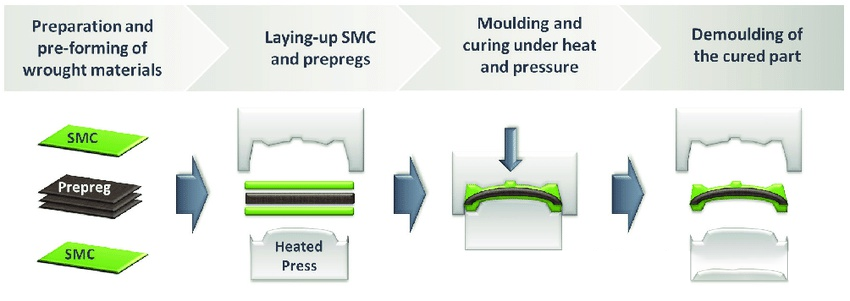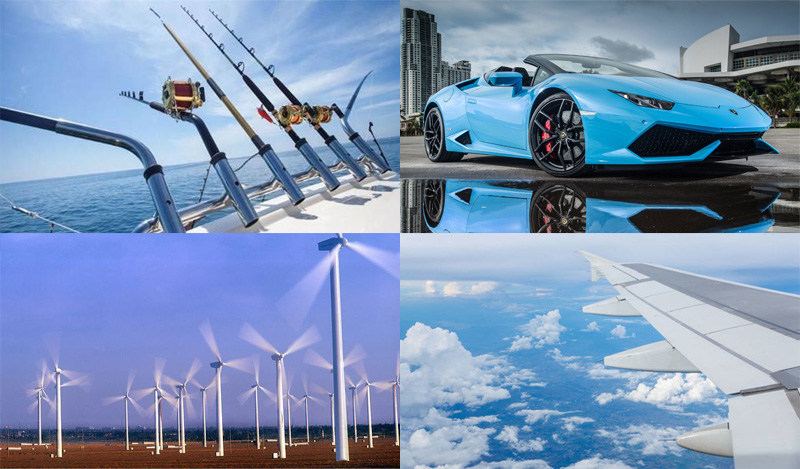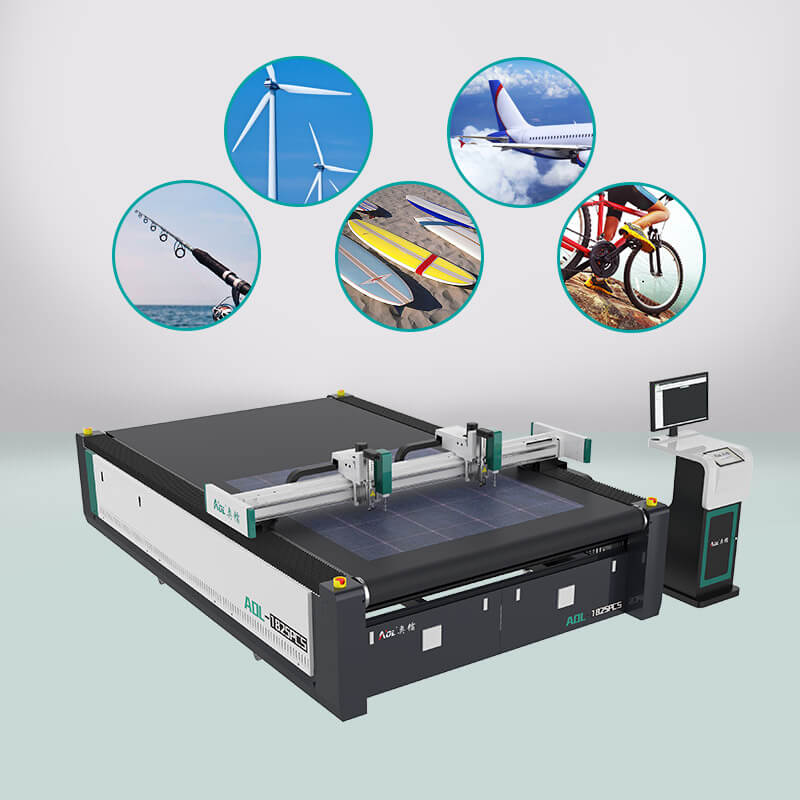What is carbon fiber composite material?
The “Carbon Fiber” that everyone often talks about is called “Carbon Fiber Reinforced Polymer” in English, or CFRP for short.
Carbon fiber is a man-made synthetic fiber material with a carbon content of more than 95%. It is obtained by using organic fiber yarn as a raw material to undergo chemical treatments such as cracking, carbonization and oxidation at a high temperature above 1000°C, and finally coating with a layer of resin. A high-performance inorganic fiber material with a carbon content of more than 90%.

Carbon fiber has the flexibility of fiber and the strength of carbon element.
It can be said that it is flexible on the outside and rigid on the inside. The strength is even higher than steel but the weight is lighter than aluminum.
Carbon fiber is black, with light weight, high strength, and various excellent properties such as easy molding, corrosion resistance, and high temperature resistance. It has been widely used in many fields such as military industry, aerospace, sporting goods, and automobile industry. Carbon fibers are classified according to mechanical properties and tow size, such as high modulus type, medium modulus type and standard modulus type; large tow and small tow type.

What are the forming methods of carbon fiber?
The carbon fiber industry chain has complex industrial processes, high technical difficulties, and high technological requirements, which makes the industry extremely barriers to entry. Taking the acrylonitrile (PAN)-based carbon fiber industry chain as an example, the product starts from raw materials and undergoes multiple steps such as polymerization spinning, carbonization, weaving, infiltration and molding to form raw silk, carbon fiber and fabric, carbon fiber prepreg and carbon fiber composite Materials and other intermediate products. Since the process adjustment at each step of the process will directly affect the quality and performance of downstream products, whether it is possible to maintain a stable preparation and process level is the technological core of the entire industrial chain. In addition, different customers have different performance requirements for carbon fiber and related products due to different demands. Therefore, whether the preparation method and process flow can be changed according to customer requirements, and the product performance can be flexibly adjusted is also a major technical difficulty for the entire industry chain.
Hand lay-up method:
It is divided into dry method (pre-preg layup) and wet method (fiber fabric and resin glue are used alternately). Hand lay-up is also used to prepare prepreg blanks for use in secondary molding processes such as compression molding. This method is a method of laminating carbon fiber cloth sheets on a mold to form the final product. The strength and stiffness properties of the resulting material are optimized by selecting the arrangement and weaving of the fabric fibers. Then fill the mold with epoxy resin and heat or air cure. This manufacturing method is often used for non-stressed parts, such as engine covers.

Vacuum forming method:
Regarding the prepreg made by laying up, it is necessary to apply pressure through a certain process to make it close to the mold, and solidify and form at a certain temperature and pressure. In the vacuum bag method, a vacuum pump is used to evacuate the inside of the molded bag, so that the negative pressure between the bag and the mold forms pressure, and the composite material is tightly attached to the mold. On the basis of the vacuum bag method, a vacuum bag-autoclave molding method was later derived. Compared with the method of using only a vacuum bag, the autoclave can provide higher pressure and heat and solidify the part (instead of the natural curing process). This part has a tighter structure and better surface quality. Effectively eliminate bubbles (bubbles will greatly affect the strength of the part) and the overall quality is higher. In fact, the process of the vacuum bag method is similar to that of mobile phone filming. Eliminating air bubbles is a major task.

Compression molding method:
Compression molding is a molding method that is conducive to batch and large-scale production. The mold is usually made of two upper and lower parts, which we call a male mold and a female mold. The forming process is to put the blank made of prepreg into the metal mold, and under a certain temperature and pressure, the blank is heated and plasticized in the mold cavity, pressurized to flow and fill the cavity, and then form Cured to obtain products. However, since the mold requires very high-precision CNC machining, this method has a higher initial cost than the previous methods.

Carbon fiber pressing process
Winding forming:
For parts with complex shapes or in the shape of a rotating body, a filament winder can be used to produce parts by winding the filament on a mandrel or core, and solidify and remove the mandrel after the winding is completed. For example, the tubular articulated arm used in the suspension system can be made using this method

Resin transfer molding:
Resin Transfer Moulding (RTM) is currently a popular molding method. The basic steps are:
- Place the prepared carbon fiber fabric blank in the mold and close the mold.
- Pour liquid thermosetting resin into it, infiltrate the reinforcing material and solidify.

In general, the “material cost” bears the brunt. Compared with traditional metal materials, the cost of carbon filaments and resin materials used in carbon fiber reinforced composite materials is very high. Secondly, the “process cost” is also quite expensive.
Compared with traditional metal processing techniques such as casting and forging, the process of carbon fiber reinforced composite materials is more complicated and more difficult, and the cost of manpower and equipment is also rising. In addition, the post-treatment process of carbon fiber reinforced composite materials will be more complicated, including the spraying process and installation of the parts.
The post-processing and assembly process of carbon fiber reinforced composite materials are also one of the high cost sources. Especially sanding, adjustment and installation and painting. It is quite different from traditional metal parts.
However, the high price cannot prevent the more and more widespread application of carbon fiber reinforced composite materials. Compared with traditional metal materials, carbon fiber materials have relative advantages in strength, rigidity, and impact resistance, and their absolute advantages in unit weight are used in more and more fields.

The application and prospects of carbon fiber
Global carbon fiber demand has grown rapidly in the past 10 years. According to statistics, global demand in 2019 was 103.7 kilotons, with a compound annual growth rate of 11.3% from 2009 to 2019, and a compound annual growth rate of 14.2% from 2014 to 2019. It is expected that the average annual growth rate in the next few years can still maintain a level of 10%-20%.
The global carbon fiber industry has experienced 50-60 years of hard work, and in 2019, the demand for carbon fiber will reach more than 100,000 tons for the first time. With continuous breakthroughs in core technologies, especially the development of the main application scenarios of carbon fiber in downstream aerospace, wind power and automobiles, as well as the reduction of carbon fiber costs and the improvement of cost performance, the total demand of the industry is expected to reach 200,000 tons in 2025. It is expected to reach more than 400,000 tons in 2030.
Global carbon fiber is mainly used in wind power, aerospace, sports and leisure, and automotive industries. Specifically, wind power and aerospace are the largest applications of carbon fiber in 2019, accounting for 25% and 23% of total demand, followed by sports Leisure accounted for 15% of the market share, and automobiles ranked fourth with 11% of the market share.
However, in terms of amount, aerospace occupies about half of the carbon fiber market. This is mainly due to the particularity of the industry. Aircraft and aircraft manufacturing have extremely strict requirements on the strength, life and stability of carbon fiber. Therefore, aerospace The price of carbon fiber grade is much higher than that of carbon fiber needed by other industries.
The sub-sectors driving the growth of carbon fiber in the future are mainly wind power, pressure vessel and aerospace. With the continuous development of carbon fiber molding technology, the cost of carbon fiber reinforced composite materials has been further controlled, although compared with traditional stamping, casting, and machining processes The cost is still high, but due to its special performance, it is more and more widely used in civilian vehicles. Especially in recent years, the development of electric vehicles and hybrid vehicles has provided carbon fiber reinforced composite materials with a wider range of applications.
The reason why CFRP is expensive
Carbon fiber is expensive mainly composed of 4 aspects
Raw materials. At present, the main carbon fiber is PAN (polyacrylonitrile)-based precursor. The most similar to it is the acrylic fiber in our lives (in addition to acrylonitrile, there is a monomer in the polymer, and the precursor is two monomers). Take the mainstream 12k as an example, about 20,000-30,000/ton. With current technology, only 1 ton of carbon fiber can be burned out of 2 tons -2.2 tons of raw silk. In this case, the cost of raw materials will be more than 40,000-60,000/ton
Equipment cost. The current complete set of equipment (from raw silk, oxidation furnace, carbonization furnace to wire feeding equipment) will cost more than 200 million tons per 1,000-ton line. The annual production capacity is about 1,500 tons.
Electricity bill. Carbon fiber is a heat treatment process from oxidation to carbon fiber, which requires a lot of electricity bills. If the current mainstream industrial electricity is calculated at 80 yuan per kilowatt-hour, the cost of carbon fiber production is as high as 25%-30%.
R&D costs. Carbon fiber is a multidisciplinary product. Including chemical polymerization, heat treatment. For textiles, etc., there are about 3,000 control points in the whole process, and the research and development costs inside are very high.

Why choose AOL carbon Fiber cutting machine
Carbon fiber materials are expensive, so they have extremely high requirements for utilization. Therefore, the cutting of carbon fiber requires precise layout and good results to reduce material waste. The cutting equipment developed by AOL cnc for the field of composite materials can perfectly solve its cutting problems.
Advantages of AOL carbon Fiber Reinforced Polymer cutting machine:
High cutting precision: AOL carbon fiber composite material cutting machine adopts Taiwan’s linear guide drive system, which can control the accuracy within ±0.1mm to meet the precision requirements of composite material processing.
High material utilization rate: The machine is equipped with super marker cutting software, intelligently typesetting according to different cutting shapes, which can increase the material utilization rate by more than 10%.
Anti-static system: Many composite materials are added with metal materials. The AOL cutting machine uses the whole machine anti-static system, which can protect the safety of operators to the greatest extent.
In addition, AOL CNC has a professional R&D team for its performance as an industry cutting, which can provide assembly line supporting solutions for the factory.
If you want to know more about carbon fiber cutting machine, please contact us.
You can send an inquiry below or send an email to [email protected]. After we receive the message, we will arrange for a staff member to contact you as soon as possible.

